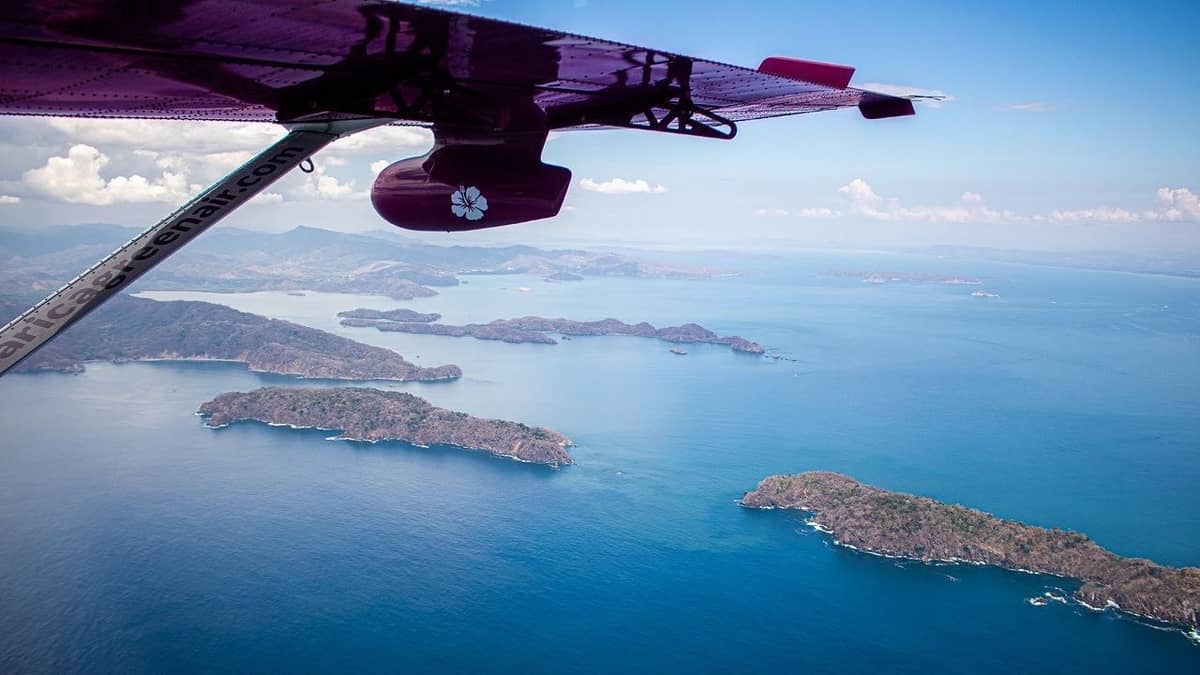A Quick Guide to the Domestic Airlines
7 min readA quick guide to domestic airlines in Central America, the little (and sometimes large) puddle jumpers that keep the region connected.
The post A Quick Guide to the Domestic Airlines in Central America appeared first on Central America.

A quick guide to domestic airlines in Central America, the little (and sometimes large) puddle jumpers that keep the region connected.
Most conversations about air travel in Central America focus on the big international hubs — the connections in and out of the region. But what often gets overlooked is the network of small airlines operating quietly behind the scenes, helping people move around within each country. They’re not flashy, and many travelers don’t even realize they exist until they need them. But once you do, it’s hard to ignore just how useful they really are.
We’re seven small countries in Central America, so you might not think that domestic flights are worthwhile, with such short distances. But, given the state of the roads, and the fact it takes much longer to drive a distance of, say, one hundred miles in Central America than it does in the United States, you’ll see why they’re essential.
Domestic airlines in Central America, along with the myriad of airstrips around the region – most of them super-basic – help keep remote communities in touch with the societies they exist in. Sure, they offer a great solution to tourists who want to get around the region fast, but for many remote and island communities in the region, they’re a lifeline.
Except for El Salvador (the smallest country by size), every Central American country has its own domestic airline or two (or even three). El Salvador, in fact, used to have TAES, but nowadays this airline operates private charters only.
So let’s take a look around the region and introduce you to the domestic airlines connecting travelers, tourists, and local people around Central America.
Domestic Flights in Belize
Belize has two domestic carriers: Tropic Air and Maya Island Air. Both airlines offer scheduled and charter services across the country. Based in Belize City, they primarily serve key tourist destinations like Ambergris Caye, Caye Caulker, Placencia, and Punta Gorda, with routes radiating out from municipal airports and the international hub.
Tropic Air is the larger of the two, founded in 1979 and operating over 200 daily flights with a fleet of Cessna 208 Caravans and seasonal Twin Otters. It also flies internationally to Mexico, Guatemala, Honduras, and El Salvador. Maya Island Air, the older of the two, started in 1962 and runs over 250 daily flights with a similar aircraft fleet. It focuses more on southern Belize and offers charters to Honduras and Guatemala. Both airlines operate with comparable pricing and flexible policies for rebooking.
While Tropic Air holds international safety certifications and runs a frequent flyer program, Maya Island Air is noted for its air-conditioned cabins and upgraded terminals. Travelers generally choose between them based on timing and convenience, as they offer near-identical routes and service levels, making getting around Belize by air super easy.
Domestic Flights in Costa Rica
The two main domestic airlines in Costa Rica are SANSA and Costa Rica Green Airways. Both operate out of San José’s Juan Santamaría Airport and serve a mixture of beach, rural, and jungle communities around the country.
SANSA is the older and more extensive of the two, founded in 1978 and flying to over a dozen destinations. Its network includes Tamarindo, Puerto Jiménez, Nosara, Limón, La Fortuna, and others, with nearly all routes connecting through San José. The airline runs a fleet of Cessna 208B Grand Caravans, reliable aircraft well suited to the country’s small airstrips.
Costa Rica Green Airways is newer, launched in 2018 by one of the country’s private charter pioneers. It’s smaller in scale, serving key tourism spots like Quepos and the Nicoya Peninsula via the new Cóbano airstrip, but it’s known for premium service and sustainability efforts. The airline also holds the Argus Gold safety certification and operates a modern fleet, including the Grand Caravan EX and Kodiak 100. Costa Rica is also home to a number of private charter operators offering flexible service to more remote areas.
Domestic Flights in Guatemala
Guatemala’s domestic air travel is handled almost entirely by TAG Airlines, the country’s national carrier and its only airline offering regular internal flights. TAG was founded in 1969 and operates out of La Aurora International Airport in Guatemala City, with a secondary base in Flores, near the Tikal ruins. The airline runs scheduled services between the capital and Flores, as well as to Puerto Barrios on the Caribbean coast. These flights are useful for travelers heading to the Petén region, which can take ten hours or more to reach by road.
TAG also has a wider international reach than most domestic airlines in the region, flying to multiple cities in Honduras, Mexico, El Salvador, and Belize. Its fleet includes ATR 72s, a Saab 340, and a regional jet, making it one of the few carriers in the region operating larger aircraft. The airline offers basic economy service with complimentary snacks and checked baggage, but no frills beyond that. It also runs charter services, air ambulance flights, and helicopter transfers to places like Antigua and Lake Atitlán.
Domestic Flights in Honduras
Honduras has a fairly active domestic aviation scene, with three main airlines operating regular flights around the country: CM Airlines, Aerolíneas Sosa, and Aero Caribe. These carriers link the country’s largest cities — Tegucigalpa, San Pedro Sula, and La Ceiba — with the Bay Islands of Roatán, Útila, and Guanaja, as well as more remote areas like Puerto Lempira on the Mosquito Coast.
CM Airlines is the largest by fleet size, based in Tegucigalpa, and flying a range of aircraft including ATR 72s, Saab 340s, and smaller regional planes. It also has a partnership with Guatemala’s TAG Airlines for international service. Aerolíneas Sosa, based in La Ceiba, has been around since the 1970s and offers a mix of scheduled and charter flights, mainly between the mainland and the Bay Islands. Aero Caribe is smaller and more specialized, focused on connecting La Ceiba with island and coastal destinations using a single LET-410 aircraft.
All three carriers play an important role in a country where terrain and infrastructure make some areas difficult to access by land. Flights are short and straightforward, with few frills, but they get people where they need to go efficiently.
Domestic Flights in Nicaragua
Based in Managua and operating out of Augusto C. Sandino International Airport, Nicaragua’s domestic airline La Costeña connects the Pacific side of the country — where most people live — with the remote eastern regions and outlying islands. Its routes include Bluefields, Corn Island, Puerto Cabezas, San Carlos, and other hard-to-reach locations in the Caribbean lowlands.
The airline uses a small fleet of Cessna Grand Caravans and an older ATR 42, which are well suited for Nicaragua’s shorter runways and regional airports. Flights are basic, with limited baggage allowances and check-in done at the airport. There’s no frequent flyer program or in-flight service beyond the essentials. That said, La Costeña plays a big role in connecting parts of the country that would otherwise require long and difficult travel by bus, boat, or road. A flight from Managua to Corn Island, for example, takes under 90 minutes. By land and ferry, the same journey can take over 12 hours. For many travelers, La Costeña is the only practical option.
Domestic Flights in Panama
Panama’s domestic air travel is handled almost entirely by Air Panama. Based at Albrook Airport in Panama City, the airline connects the capital with provincial cities, island communities, and harder-to-reach regions. Its regular destinations include Bocas del Toro, David, Chitré, Pedasí, Changuinola, and the Darién region. Air Panama is the country’s second-largest airline, behind Copa, and has been the main domestic carrier since its main competitor, Aeroperlas, ceased operations in 2012.
The airline’s history dates back to 1980, when it was founded as PARSA. It rebranded as Air Panama in 2005 and expanded its fleet to include both turboprop and jet aircraft. Today, it uses a mix of Fokker 50s and Fokker 100s, with a focus on short- to medium-haul routes. Service is simple and efficient — economy class only, with complimentary snacks on board and a few fare options depending on baggage and flexibility. Air Panama previously ran international flights to Costa Rica and Colombia, but these routes have mostly been suspended. Charters are still available to the San Blas and Pearl Islands, especially during peak tourism seasons.
Ready to Puddle Jump?
Adding them up, that’s quite a few airlines (ten if you’re counting) flying through the skies of Central America. Not bad for a bunch of small, poor countries. Most of the planes in these airlines’ fleets are small prop planes seating some 15-20 people max. Air Panama, TAG, and some of the Honduran airlines have some larger planes, though. As mentioned, TAG even has a jet! But for the most part, it’s smaller, lighter planes that work the region, all the better for some of these small, remote airstrips.
Small planes, of course, mean small luggage allowances for passengers. Check with the individual Central American airline directly, but chances are you’re limited on how much you can bring with you. That’s a simple fact of life, and one of the trade offs you get in exchange for speed, excitement, and amazing views.
So what are you wanting for? Whether you live in Central America or you’re traveling in the region, get on a plane and explore somewhere new.
James Dyde is the editor of centralamerica.com. He lives in Escazu, Costa Rica.



